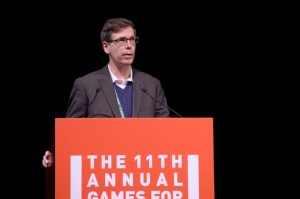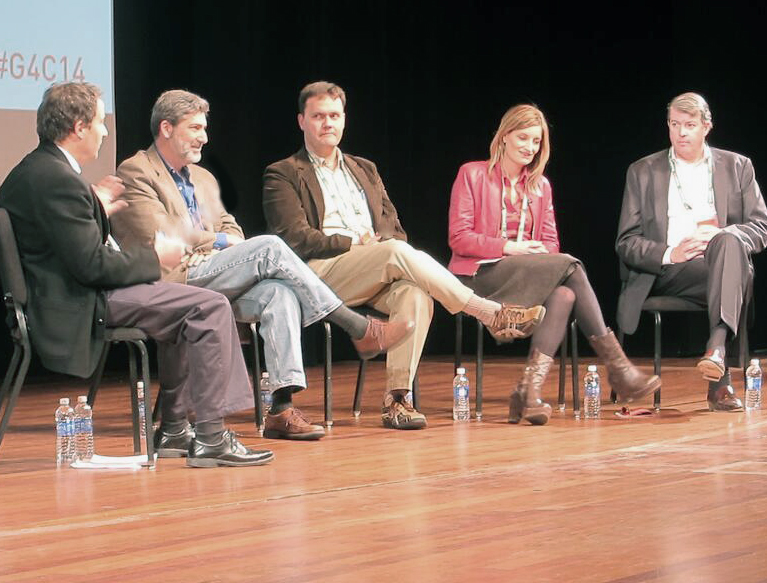Are we living in a fantasy?

Source: Dave Kotinsky/Getty Images North America
Of the 70 or so panels, celebrations, play tests, and keynotes that took place last month at the 11th Annual Games for Change Festival in New York, nearly all made some mention of the potential for educational games. So what’s with all the hype? Why games and why now? As the Cooney Center’s Executive Director Michael Levine put it in his speech on the last day of the festival, “In the face of global stiff competition, the alarm bells are ringing if we hope to sustain our leadership in innovation.”
Games hold the potential to help our young people receive the education they deserve, said Levine, adding that continuing to improve the amount of “engaging content” in our children’s lives will be key to providing them “relevant and rigorous learning.” But is it possible that such ideas are only welcome at a utopian event like Games for Change? Maybe reality can’t accept the fantasy presented by educational gaming.
But maybe it can. “[My] fifth grader has used digital games extensively over the past two-to-three years,” said Kevin Bushweller, a journalist for Education Week and moderator of the G4C panel “Turning Fantasy into Reality: Building Games that Schools Need”. “She has gone from hating math with a passion to now attacking it in an analytical, creative, and persistent way. And I’ll be honest, I attribute that largely to the strong link between instruction and assessment in the learning games she has used.” The panel, curated by the Cooney Center, focused on the needs of the marketplace and the kinds of games teachers look for when designing a curriculum. The four panelists were:
- Chris Curran, founding and managing partner of Education Growth Partners
- Alan Gershenfeld, founder and president of E-Line Media
- Jesse Schell, CEO of Schell Games
- Constance Steinkuehler, associate professor at the University of Wisconsin
In order to steer the discussion in the direction of reality, Bushweller chose questions grounded in evidence from the educational world. Here are three stand-outs from the conversation:
What are the biggest mistakes game developers make when trying to create games for the K-12 market?
Jesse Schell warned against assuming that your great idea will sell itself. “Really, there are so many complexities and layers to the marketplace,” a point which the rest of the panel seemed to agree with. Chris Curran brought up a study he led last year that investigated 75 different learning game companies and found that game development for education focuses around providing automaticity, satisfying Common Core requirements, and enabling the instructor to multitask.
But once the game is made, the marketplace is open water. To navigate, E-Line Media (Alan Gershenfeld’s company) has developed four business models:
- licensing their games to schools
- sending company personel to teach or co-teach a class
- offering teacher professional development opportunities, and
- seeking sponsorship from third-party organizations
But, said Gershenfeld, it takes a lot of research and the results vary widely depending on the age of the students.
What is the state of educational gaming research?
Constance Steinkuehler pointed out that one of the biggest mistakes designers make is not including teachers in the design process. They should ensure they aren’t creating a “solution looking for a problem that no one ever had.” Additionally, Steinkuehler (a researcher) implied there might be an essential flaw in the way research is presented. “There is not a single event that I do where someone doesn’t ask me, ‘What’s really the state of research in games and learning?’” Maybe we, as researchers, should be asking ourselves: what more can we do to get our information in the hands of developers?

Source: @G4C, edited
Earlier this year, together with the Games and Learning Publishing Council (of which Steinkuehler and Curran are both members), the Cooney Center launched GamesandLearning.org, which “reports on the opportunities and challenges facing those seeking to unlock the educational power of games.” The website contains up-to-date material based on the latest in games and learning research, and a Twitter account that brings this research to the social web.
Fortunately, there is a lot of good news in gaming research. Steinkuehler made note of the exciting (and result-yielding) games being made on the topics of language learning, history, and physical education. And although math and science games show more mixed results (in spite of the ample funding attracted by those subjects), she said not to confuse “mixed results” with “no results.”
How do we convince schools that gaming is going to help make education better even though it’s not aligned to Common Core and academic subjects?
“I actually think it’s better aligned than people think,” said Alan Gershenfeld. And from his perspective as an investor, Chris Curran added that it’s important to consider how your game will help the teachers meet their Common Core standards more efficiently, or else “it’s going to be very difficult to get it into the classroom at all.”
Possibly the most positive thing to take away from this panel was that there is a significant opportunity for developers to take leadership in the world of educational gaming, the kind that, Gershenfeld said, comes only once in a lifetime.
The textbooks are going away, curriculum is becoming unbundled … technology is now in the classroom … you have the assessments changing, the Common Core, the NextGenSci standards … a lot of press about a disconnect between what employers need ? what people need ? to thrive and be successful, and what we’re teaching. Personally, I believe in general, when you look at the new assessments, you look at the new standards, you look at what employers want, you look at what people really need to thrive, they tend to align well with inquiry-based learning, blended learning. … But the fact is it’s really hard to design, develop, implement and support those types of learnings. I believe the people who can do that are going to experience enormous success.
Who will take this opportunity to build a bridge between fantasy and reality? Is there anywhere the bridge has already broken ground? Stay tuned for part two of this post to find out.



